Neil Peart's News, Weather and Sports
Eastern Resurrection
NeilPeart.net, May 2011
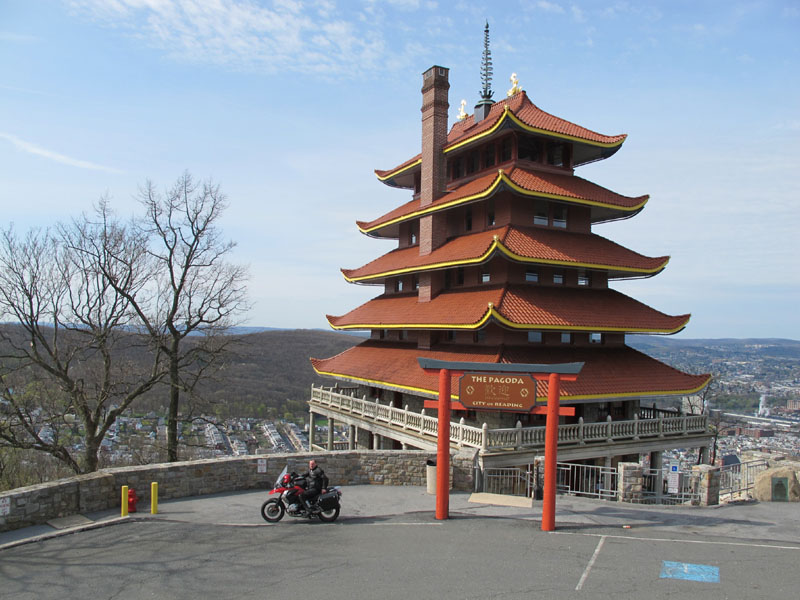
"Eastern" can refer to this pagoda, with its Chinese design, and in a different way, to its location - not in the Orient, but in the Eastern United States. It stands atop Mount Penn, overlooking Reading, Pennsylvania, where Michael and I stayed a night in late April. We were on a long backroad ride between the Adirondacks in upstate New York - where a few deep snowbanks lay in the woods, and flying snow filled the air - and Baltimore, Maryland, where flowers carpeted the woods, and spring filled the air.
The pagoda was built in 1908 by William Abbot Witman, a local quarrier who wanted to beautify the city whose hillsides he had been stripping bare. He planned the edifice to be a landmark hotel and restaurant, but it was never opened - the need for a suitable access road up almost 900 feet of steep mountainside being the biggest apparent obstacle.
In the background of this photo, the streets and hillsides of Southern Pennsylvania are beginning to show sprays of green among the trees - an effect I came to think of as "The Airbrush of April." Those first signs of post-winter rebirth, the radiant bursts and washes of spring color, are so expressive of returning life, and are one reason why the word "resurrection" occurred to me for this story. Even as the band was reviving the Time Machine tour, bringing it to a new series of North American cities and countries outside North and South America (heading to Europe in May), and I was resurrecting my drumming and motorcycling skills and endurance, all around me the world was being reborn.
My April travels with Michael on this sequel to last year's Time Machine tour carried us from Florida up to Quebec - thirteen shows and 3,800 miles of motorcycling between them. The weather varied from warm and blossoming across Tennessee to a polar wasteland in Ontario.
We traced thousands of miles of Eastern backroads in April, weaving north and south and north again. Through different zones of latitude, I witnessed every stage of spring, in Tennessee, Kentucky, and West Virginia, and gradually farther north. Sometimes we looped south again through Ohio or Pennsylvania a week apart (seeking warmer weather on days off, usually in vain), where we saw markedly different phases of spring rebirth in the same countryside.
Locally, that progress was clearly represented by a series of natural stages. First was the greening of the lawns and roadsides, as the grass recovered its living color, along with the daffodils and crocuses in people's gardens. Then the first blossoms flared in vivid sprays of color, those that flower before they leaf, like the bright yellow forsythia bush that was familiar to me from my youth in Southern Ontario, flaming along driveways and housefronts in early spring.
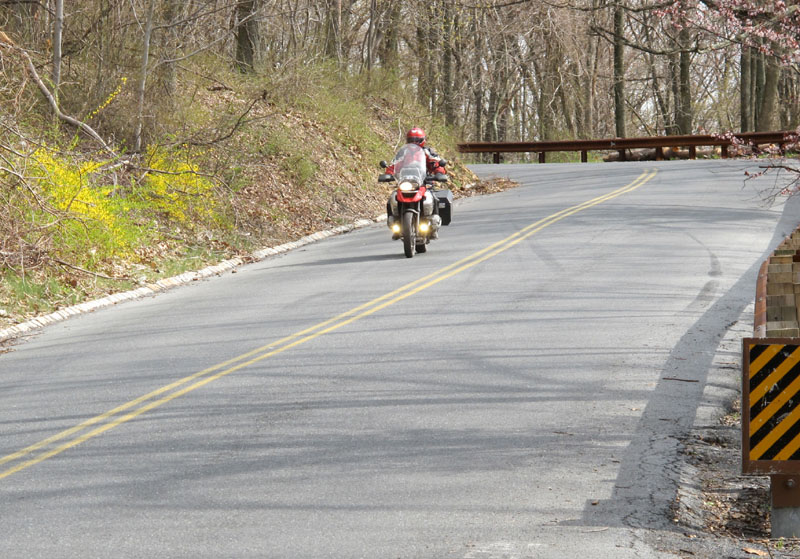
The following photo was taken on the road down from that pagoda atop Mount Penn (the road's complicated engineering a testament to Mr. Witman's problems over 100 years ago). Among the green washes at the roadside, a spray of forsythia glows yellow, while to the upper right, among the mostly bare, gray branches, a magnolia tree flowers in pink and white.
In the fifteen years I have been traveling on concert tours by motorcycle, the band has never toured in the East at that time of year, and it truly was a revelation to me. On April 4, our first ride led through the open woods of Tennessee, on the way from a show in Greensboro, North Carolina, to one in Nashville. While Michael and I followed the gentle curves and contours of two-lane roads, passing fields and lawns fresh with green, the woodlands remained a stark gray-brown network of bare trunks and branches. But I started to notice increasing numbers of small trees that glowed with vivid magenta blossoms, standing out all the more for being the only bright color, between the gray pavement, greening roadside, bare woods, and blue sky.
Those bright flourishes of purple decorated the open woods across Tennessee, though on the next day's ride, north into Kentucky, we didn't see them. Curiosity piqued, I started asking local friends and browsing websites, and learned that they were called redbud trees - and was surprised to learn that they are very common throughout the Eastern U.S., even to being the state tree of Kansas. In summer, the redbud trees trade their blossoms for leaves, and become just another small, unremarkable tree among the dense green foliage. But in April, the redbuds glorify the woods with an Easter-egg shade of purple (add the yellow of forsythia and robin's egg blue, and you've got a fine palette for Easter - a possible pun in the title, I confess). I soon observed that the northward spread of redbud blossoms was a sure herald of approaching spring across the East.
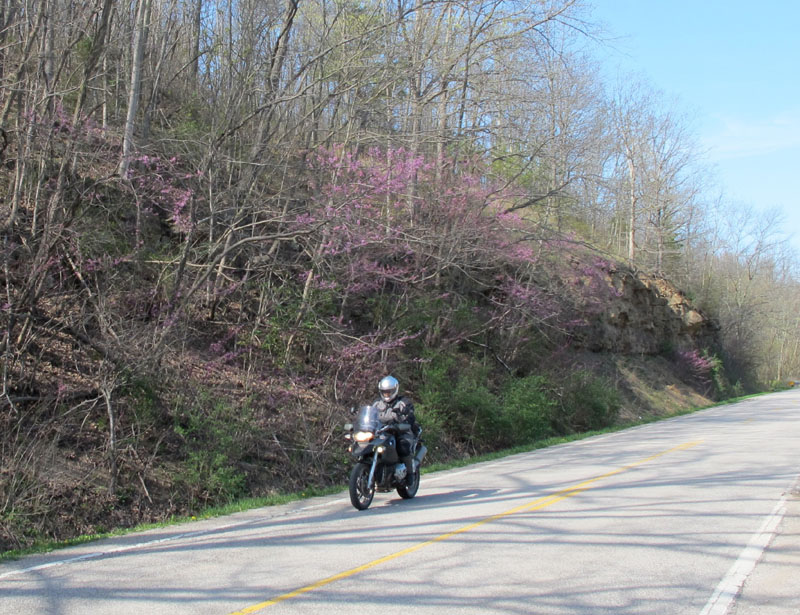
So again, all of that "spring fever" blazing in my eyes, and in my mind, was part of the reason why "Resurrection" demanded to be part of this story's title. Also, the states through which most of our travels led us - Tennessee, Kentucky, Ohio, Indiana, West Virginia, even Pennsylvania - are among the most vehemently, loudly, Christian parts of the country. The bible belt becomes the bible bellow, shouting at you all over the place.
The church signs I have often cited, like the generic "Free Ticket to Heaven - Details Inside," were common and mostly unoriginal. Several gigantic billboards towered high above the road, urging us to "Be an Organ Donor - Give Your Heart to Jesus.
On another vast billboard, the left half was scrawled with huge ragged letters slashing out the word, "SIN," while on the other half was a block of text in quotes, "It Seemed Like a Good Idea at the Time."
Michael laughed and said, "It always does!"
In the temperate regions of the northern hemisphere, April is a time of rebirth - celebrated since prehistoric times by the good old pagans. In the same way that Christianity co-opted the pagan midwinter festival as a good fit for their own celebration of their savior's birth (for which choice of season there was never any evidence, biblical or historical), naturally the return of life to fields and forests after the ravages of winter made a perfect metaphor for their savior's crucifixion and resurrection. Again, the pagans had celebrated that spring equinox since time immemorial.
Some church signs in April reminded us that "Jesus is the Reason for the Season," as they do around Christmas, but I guess it's not really true. You might as well say, "The Season is the Reason for Jesus."
One moderately clever church sign read, "Jesus Paid the Price - You Keep the Change."
A modestly-sized sign set low in front of a small-town church particularly caught my eye, and occupied my reflections for many miles down the road. It read, "The Easter Bunny Didn't Rise From the Dead."
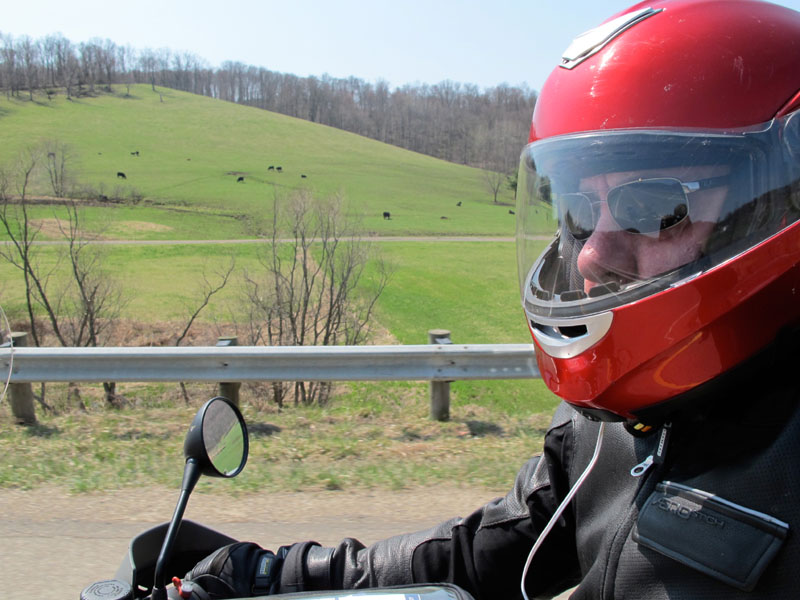 |
West Virginia hillside airbrushed green, and dotted with cows |
Apart from its scolding piety, I couldn't help but think of one Easter Sunday when I was about seven, brother Danny four, and sister Judy three. That morning the three of us looked into our backyard and saw the bloody remains of a rabbit near the doghouse of our beagle mix, Trixie. Dad shooed us away and went outside with a shovel, leaving us kids traumatized that our dog had killed the Easter Bunny. Soon after that, Trixie (who apparently had other behavioral problems than childhood-icon-slaying) "moved to a farm" (Danny has never forgiven Mom and Dad for that euphemism), but for Danny, Judy, and me, the Easter Bunny didn't rise from the dead.
Over our post-ride cocktails and dinners, Michael and I discussed all of those church signs and billboards, and the mentality behind them, as well as all the variations on the theme of resurrection. One time we must have startled a Christian friend, who was standing by and listening silently as these two apparent heathens discussed the last sayings of Christ on the cross. For reasons I can't begin to imagine, I remembered the Aramaic of the only saying substantiated in two gospels, when Jesus shouts to the sky, "Eli eli, lama sabacthani?" - "My God, my God, why hast Thou forsaken me?"
Michael and I know our Judeo-Christian theology pretty well - we both had that kind of upbringing, and have always been interested in matters philosophical and supernatural - matters which obviously combine most strongly in religion.
Among Michael's other security tasks, he keeps an eye on the mail that comes my way, and he shared one message from a reader that he thought was humorous. It was from someone who enjoyed my writing, but admonished me not to be a "faith-basher."
That gave me pause - the name, not the idea.
I don't want to be any kind of a "basher" (except on the drums), and thinking over that concept launched a train of thought - a train hauling boxcars full of mental freight that will need to be unloaded sometime soon (on you, patient reader).
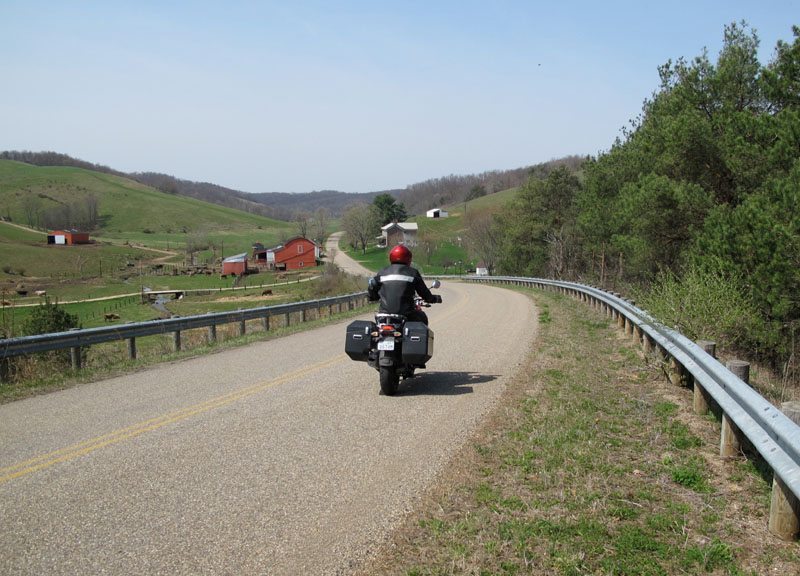
But first, here's a lovely little valley in Southern Ohio, just over the river from West Virginia. I saw a bluebird on the wing that morning - always a happy sight. We were returning from a two-day ride from Cleveland southeast through rural Ohio and West Virginia (just incidentally, I am sure that state has more one-lane paved roads - the rarest in the land - than any other) to overnight in Charleston, then back up to Cleveland for the show. I really ought to be able to sell that route to other riders, it was so good - a million-dollar ride that would surely be worth, oh, ten dollars, for another rider to profit from my years of experience, knowledge, and roadcraft in designing that route ...
A minor scene in a book by Paul Theroux has stuck in my mind for many years, and until recently, I could never figure out why. Now I realize that the scene is a portrait of the psychic response to being called names by strangers, especially in print. The book is My Other Life, one of Theroux's "fictionalized autobiographies," about a writer named Paul Theroux who, in one chapter, is traveling on a book tour in Australia. (I laughed out loud when he had a hotel bellman call him "Mr. Thorax.")
As I remember the scene (from reading it fifteen years ago - I can't verify it now because my copy is in my other library in Quebec), the "other" Paul Theroux meets an attractive Australian journalist, impeccably groomed and sophisticated, and when their flirtation reaches its tipping point, she suddenly pulls out one of the author's books about a train journey, in which he described a scruffy Australian girl rutting in the berth below him. Pointing at that passage in the book, she says, "That's not me."
Of course, Mr. Thorax and the reader are intended to understand that it was her, but she could not live with being described in such a way, at such a moment, for all time. The character's intent was a deliberate desire to change the author's perception of her.
What made the passage stay with me, I think, is that it's such a human response to being categorized, especially in an unflattering way. Many of us spend a lifetime receiving others' impressions of us, and thinking, "That's not me." (Also the title of a great old Brian Wilson song, but with lyrics by Tony Asher that are more about self-reflection than one's reflection on others.)
Recently I read a theory that the way others saw us in high school has much to do with the adults we become. That notion offers a deep well of reflection, and definitely has some truth to it, but I would say most of our imprinting comes even earlier, as small children. If as a child you were told you were dumb, incompetent, thoughtless, and selfish, say, or made to feel that way, you might spend the rest of your life trying to prove, "That's not me."
Even in grownup life, when you learn that someone has a bad impression of you that you feel is unjust, you might set out to show that person a different you. It has happened to me, in both directions.
But alas, I may have to live with being called a "faith-basher." I simply can't think of a way to prove it untrue. And in any case, in today's world there are many more people who will bash you with faith than for it.
I think of a large sign I saw on a lawn in Harrisburg, Pennsylvania, that made my eyes pop in my helmet:"African-Americans Murder 60% of Their Unborn Children in NYC."
I had to slow down and read it again to believe what I was seeing - at first I literally did not believe my eyes. It wasn't the message that so shocked, but the messenger - and those racially specific words. (Like when we rode Interstate 68 out of West Virginia and across Maryland, and passed the sign for Negro Mountain. Michael and I both had to look twice to be sure of what we were reading.)
In this case, it amazed me to think that one individual had decided that displaying that particular message in front of his or her home was a good thing to do - to express their disapproval of other people's actions and beliefs, and tacitly express their own faith in a god-given right to control those actions and beliefs.
Around the bellow-belt, there was a lot of that kind of finger-wagging self-expression, and I wonder if being appalled by that arrogance is really faith-bashing. When people ram their beliefs down your throat, you can't help but spit them out.
Among the ultimate faith-bashers, in the best sense, are Trey Parker and Matt Stone of South Park fame, and on a night off around our show at Madison Square Garden, my wife Carrie and I went to see their Broadway musical, The Book of Mormon. The next day I wrote to thank my friend Matt for the tickets, under the title "When only one word will do." That word was "GENIUS!"
(I laughed when Matt replied, "It's a great date night, right?")
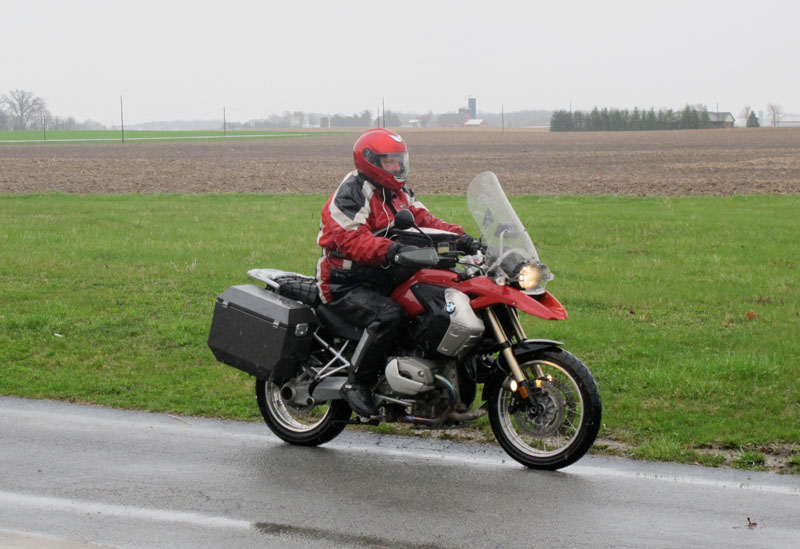 |
Cold, rain, and wind in Indiana |
The show is a brilliant piece of musical theater, and I also loved one quote Matt gave in an interview about it, which particularly went to the faith-basher accusation: "We figure God can take it - because he sure can dish it out!"
This was a particularly nasty April day, and as I rode along the backroads of Ohio and Indiana, I was trying to figure out how to capture a photograph of such riding conditions. I was hoping for one of those little bus-shelters for children you sometimes see in rural areas, figuring I could put Michael there, and have him photograph me riding by through the rain.
However, such a setup never appeared. In one small town, I pointed and signalled us into a spray-wash (previously imparted "roadcraft" - rare shelter for a motorcyclist on a rainy day). We parked inside, out of the rain, got off the bikes and smoked a Red Apple, while Michael, as usual, thumbed his handheld device. (One female friend calls him "Texty McTexterson, from Textybrook, Texas.") I looked at the driveway behind, with rural fields beyond blurred in the steady rain, and saw the photograph I wanted. Michael and the camera stayed dry while I rode slowly past in each direction. (Sometimes you just have to give those secrets away.)
Toward the end of last summer's series of shows, the first go-round of the Time Machine tour, my bandmates and I agreed that we were still pleased by that musical and visual presentation, and wanted to bring it to audiences in other places. Our manager, Ray, was quick to note that there were many cities where we hadn't performed that tour - Cleveland, Detroit, Montreal, Vancouver, and so on. Because the band's live shows have been so popular these days (something to be grateful for, all right), and the three of us feel that we are playing at a higher level than ever before (while recognizing that at our advanced ages, that upward curve cannot last forever), we decided that rather than locking ourselves away in a studio to finish the Clockwork Angels album we have been chipping away at since, oh, 2009, we would do some more shows this year.
In the spirit of giving away the "secrets" behind some of the photographs I choose, I asked John ("Boom-Boom" - our pyro technician and photographer of daily events) how he captured this amazing image. He told me he had to scale the rigging behind us, then climb sideways along the truss above the video screen. Then he had to wait for the lighting to be right, and for the three of us to be facing each other. (The end of "The Spirit of Radio" is my guess.)
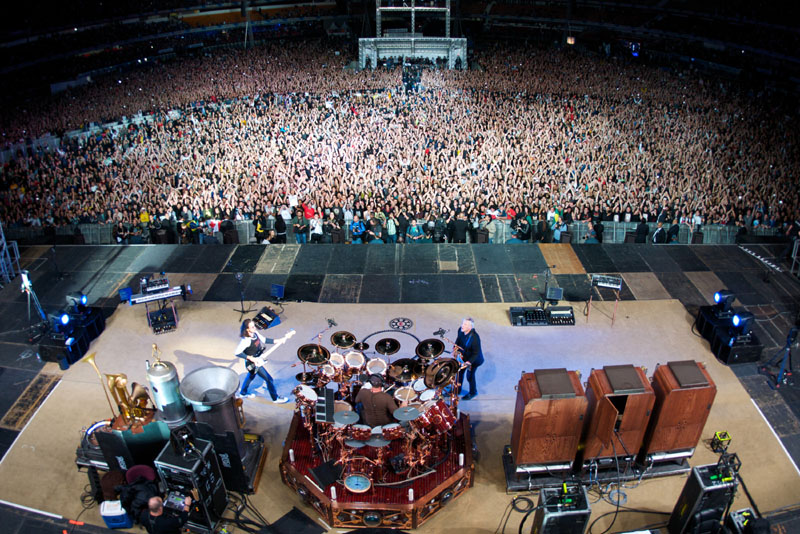 |
São Paulo, Brazil, October 2010 |
A few days ago I inscribed a print of this photograph to Boom-Boom with, "This is art - the hard way." And the meanings are multiple: Those three guys down there, and that vast crowd in front of us, are the main reason why we had to do some more shows this year. Because we could!
But to quote another church sign, "God Makes All Things Possible - Not Easy." (That is a good one.) As I have mentioned plenty of times, touring is hard, both physically and emotionally - and that last effect is particularly wrenching for me these days, with a darling baby girl, Olivia, only around a year-and-a-half, at home, without Daddy - and Daddy away, without Olivia. Grownups can miss each other while understanding why they're apart, but of course it's different for little ones.
Hoping to help Olivia understand why Daddy had "abandoned" her, I made her a little picture book called Where's Daddy? I explained how people have jobs (a difficult enough concept to simplify for a toddler, but I came up with what I think is a good definition: "It's how we all help each other"), and showed pictures of doctors, farmers, restaurant workers, tailors, and so on. Then I showed a photo of me playing onstage with the band, and wrote, "Daddy's job is different - Daddy plays the drums for people."
I introduced her to Uncle Alex and Uncle Geddy, with photos of them waving to her, and then pictures of how Daddy travels - an airplane, a bus and trailer, and a motorcycle. Then I assured her that Daddy would be home soon, and showed pictures of all the things we would do together, ending with "Because Daddy LOVES to be with Olivia," then a photo of me alone on a dock in Minnesota with the satellite phone (from the story "Cruel Summer"), with the caption, "And Daddy HATES to be away from Olivia."
The first time I read the book to Olivia, as we have read so many other picture books together, nestled close on the sofa with my arm around her, I really could feel her taking it in.
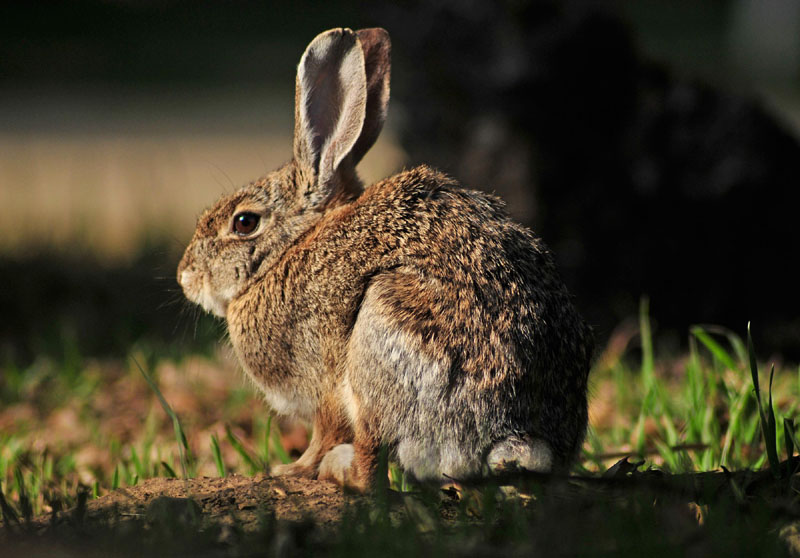
Turning the page, we then looked at a photo of a newborn Olivia, clutching my finger in her tiny fist (from "The Ballad of Larry and Suzy"), with the caption, "But right from the first day Olivia was born, she could see that life was going to be complicated."
Then this photograph by my friend Craiggie, as a necessary distraction from all that seriousness:
When it comes to discussing our working schedules, these days each of us bargains with Ray separately, which helps to avoid any unnecessary disagreements before Ray can "broker" a consensus among us. For my part, I wanted to be home this summer with my family, but offered to tour in May and June.
Ray countered by saying that the other guys were keen to bring this show to Europe, and I was not against that idea (the motorcycling!), so we'd really need another month to accomplish that. Ray proposed working in April as well as May and June. I knew the motorcycling weather in April could well be dicey, but Ray promised to keep that month's itinerary to the Southern states.
Well ... we did start in Florida, North Carolina, Kentucky, and Tennessee, but then all of a sudden we were in Ohio, Pennsylvania, New York, Chicago, Detroit, and even Ontario and Quebec. (Though admittedly, southern Ontario and Quebec ...)
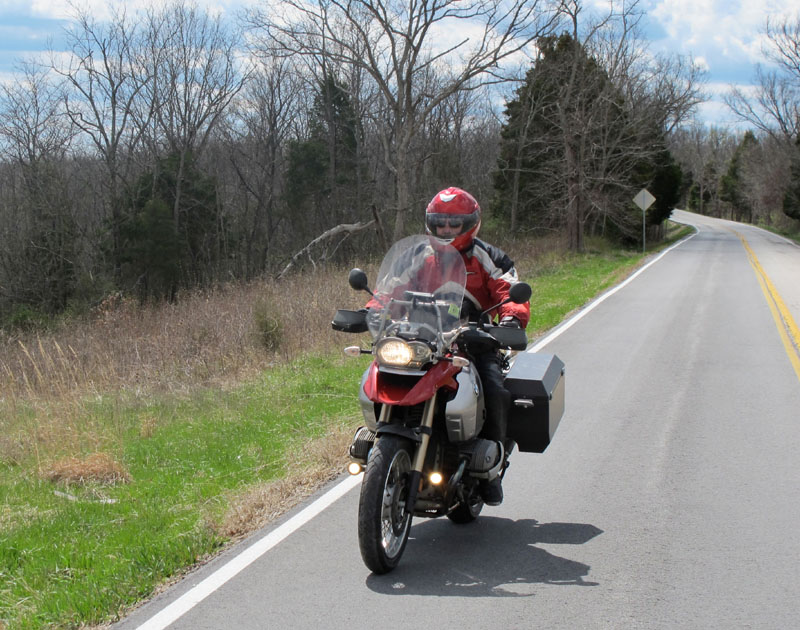
Here is an early April day in Kentucky, but apart from the green grass, the photo could as well have been taken in November. The day's temperatures were November-like, too, in the forties and fifties Fahrenheit. Further north, it would be worse ...
However, back in January, when I noticed how Ray had tricked me with the itinerary, I told Michael we had better look into some heated riding gear. For many years, in cooler weather I had used an electric vest - made with an electric-blanket type of technology, it is wired into the bike's electrics, and helps to warm your inner core. Our bikes have heated grips, too, so our gloved hands stay fairly warm - but I had always found that in chilly weather, no matter how well my feet were socked and booted, they got cold. If your feet are cold, you're never going to be happy. I wanted electric socks!
(More than one friend has commented on that good band-name: the Electric Socks.)
A company called Gerbing makes a variety of heated clothing, mainly for motorcyclists, but also for the U.S. Department of Defense (special ops, Michael and I guess - winter-motorcycle-ninjas), and we ordered their combination of vests, socks, and gloves.
Revelation!
Warm feet!
("Winning!")
At the end of our first long ride on a cold day, on April 4, up through Kentucky to Lexington (an unplanned refuge from the violent weather that rocked the Eastern U.S. in early April), we raised our glasses and toasted, "Gerbing - blessèd be thy name!"
Now it seemed that wind was our worst enemy, especially added to rain. On a few rides, like when we had to make some miles on an interstate across Ohio and Michigan on a day of fierce quartering winds, the riding was more like a wrestling match. Four or five hours of fighting against the steady wind, the sudden lulls in underpasses, momentary stronger gusts that were almost overpowering, or the bow-waves of the semis as we passed them, left us with aching shoulders.
But we had one more weather extreme to face. On April 18, I awakened in a Best Western in Sarnia, Ontario, and what I saw through the open curtains was unbelievable - once again, I literally did not believe my eyes. I closed my eyes, rubbed them, opened them again, then got up and stepped closer to the window. Sure enough - about four inches of snow covered the ground, the trees, and our bikes.
Every morning on tour it is my joyful responsibility to awaken Michael, usually with a drum pattern tapped on his door, or a rattle of the curtains over his bunk, and "Wake up, Wendy! It's time for school!"
That morning I ran to Michael's connecting door and pounded on it, calling out "Michelle! For once you don't have to get up - but you have to get up. Come and see this!"
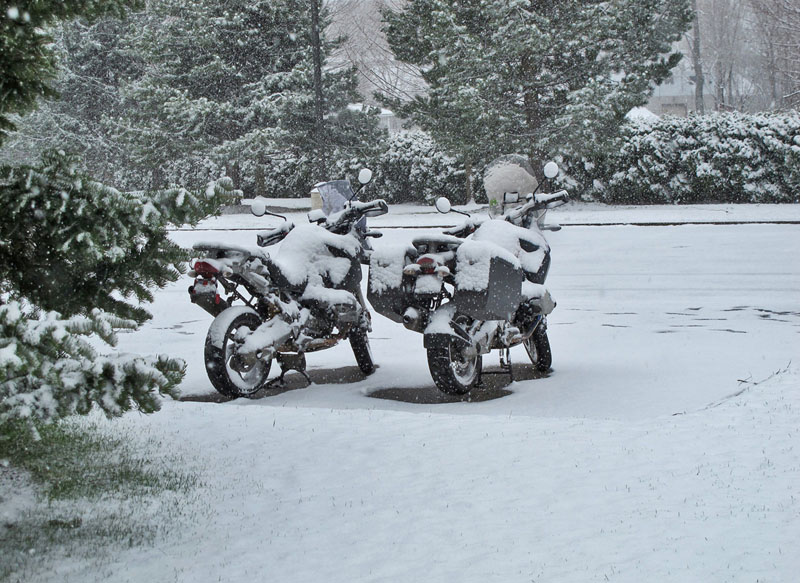
And what to his wondering eyes did appear ...
Well, obviously there would be no motorcycling that morning, but it was a day off, so we didn't have to go anywhere. I had planned a backroad ramble around Ontario for the day, ending up in Hamilton for the following night's show, but if the snow remained, or increased, we might need to be rescued by the bus and trailer. I sent this photo to bus driver Dave's phone (he was in Toronto, taking my other bike in for service), and texted him, "There might be a change of plans."
Michael and I took a "snow day," lazing around and going to see a movie (the Arthur remake - we thought it was a good "date movie"). We adjourned to Norm's Pub and Grill next door, and watched the Montreal Canadiens game (I had to explain to Michael what a "body check" was) on the usual six or eight flatscreens in such "sports-bar" establishments.
Through the day and evening, the snow melted on the pavement, and eventually off the bikes, and the following morning we were able to ride to the show in Hamilton, but it was bitter cold, barely above freezing and gloomy gray.
Riding a motorcycle on a day that's even just moderately cool - say 45° Fahrenheit - gives you a wind chill at 75 mph that is, literally and palpably, freezing. (I have noticed over many long rides in hot or cold weather that I can feel a difference of two degrees, up or down.)
On days like that, electric socks are way better than prayer, and generally, technology is superior to superstition in counteracting a day's weather, roads, or medical problems. However, I do suspect no human is completely immune to superstition.
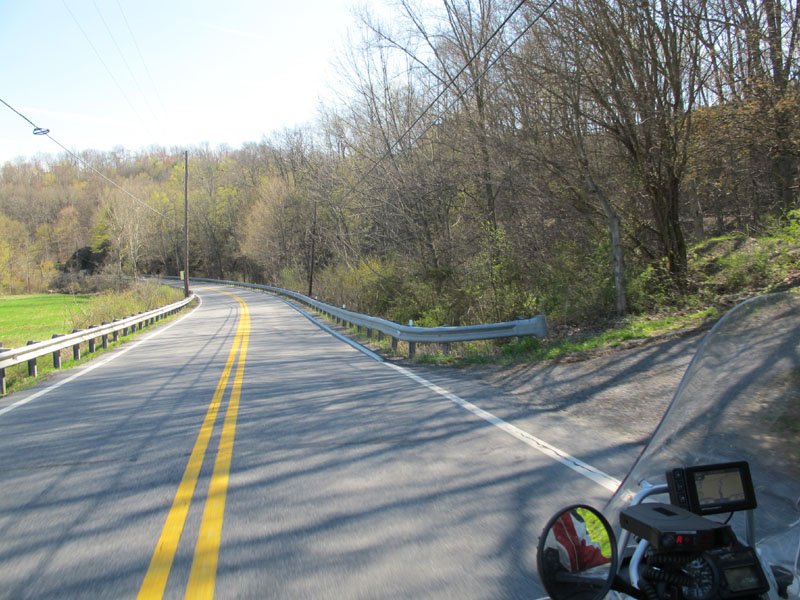 |
"The Airbrush of April" |
I have written before that as a child of five or six, I devoutly believed I could alter reality - escape punishment - if I worried about it enough. That was prayer. In Ghost Rider I wrote about the stunningly accurate tarot reading I had from a Vietnam veteran on Venice Beach, California.
Recently a Harley-riding friend gave me a "freedom bell" for each of my two motorcycles. I hadn't heard of them before, but they are small metal bells embossed with a motorcycle (an old Indian, by the look of it), and a tinkling clapper inside. The freedom bells are to be hung from a low point on your motorcycle, near the road, to capture Evil Road Spirits before they can cause you mechanical ills or crashes.
Road Spirits can't live in the presence of a bell. They get trapped in the hollow of the bell. Among other things, their hearing is supersensitive. The constant ringing of the bell and the confined space drives them insane. They lose their grip and eventually fall to the roadway. (Have you ever wondered how potholes are formed?) The bell has served its purpose.
Apparently the magic is doubled if the bells are given to you, and I thought, "why not?" While I was working on my new 1200 GS before the last American show of this run, in Baltimore (draining the gas and oil for its journey to Helsinki with the band gear), I carefully tied a freedom bell (reef knot) from the centerstand crossbar. There it will dangle above the roads of Europe while I ride, and capture those Evil Road Spirits.
Brutus will be riding my second bike over there, while Michael will be traveling with the crew and concentrating on security, so I'll see if he wants the second bell on his ride.
Another superstition I find irresistible is fortune cookies, and on one of our first rides of the tour last summer, at a Chinese buffet in Artesia, New Mexico, Michael and I received some interesting fortunes.
Mine read, "You are soon going to change your present line of work." (On the day before the first show of a tour that continues almost a year later, no points there.)
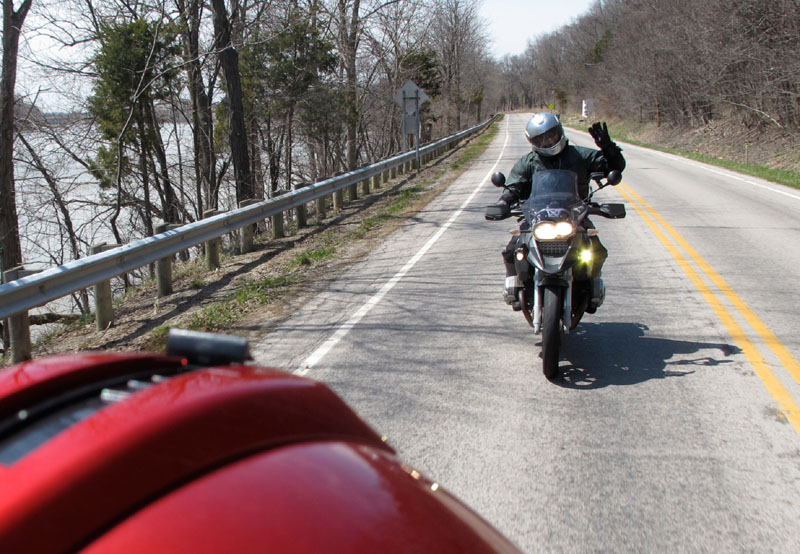 |
Along the Maumee River, Indiana |
Michael's fortune was more prescient: "You are about to become $8.95 poorer. ($6.95 if you had the buffet.)"
And it all came true! Doubled!
(Plus tax and gratuity.)
One superstition I do cling to is that when I'm home for a break in a tour, I don't look at exactly what day I'm leaving. Sometimes I have a feeling it's a Tuesday, and live and take care of chores accordingly, then find out I don't leave until Wednesday, and it is the sweetest of bonus days. Better even than the "snow day" in Sarnia. (Michael insists on calling that day "The Chronicles of Sarnia," but I refuse.)
When I opened my motorcycling journal to start this tour's notes, I noticed a lone entry on the last written page. It was from after I returned home last October, from South America, after having been away touring for most of the previous six months. I remembered the moment I wrote that entry. Jet-lagged, I had been up very early, even before fourteen-month-old daughter Olivia's usual 6:00 wake-up call, and the house was dark and quiet as I stood in the downstairs hall. Upstairs, Carrie was asleep, Olivia was asleep, and our golden retriever genius-love-sponge, Winston, was sprawled in the hall, and all of them were safe.
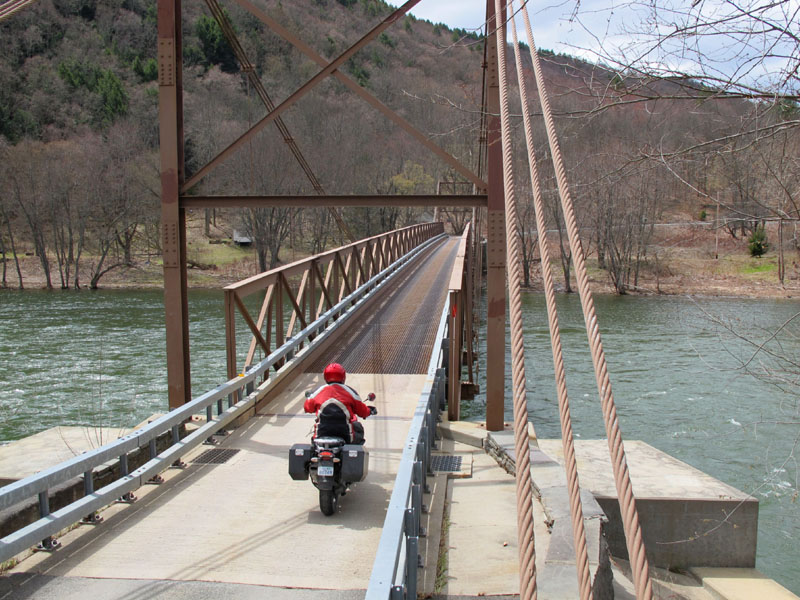
I had a sudden feeling of peace - "everything is all right" - and realized that I never get that feeling on the road. I fetched my journal and recorded my new understanding of what home means.
Feel more complete here - because those who matter most are right here.
On the road, maybe feel more alive - more fiercely in the moment - but never as if "everything is okay."
That is a feeling I can only experience at home, when I know from moment to moment that my loved ones are all right.
Because the Easter Bunny didn't rise from the dead.